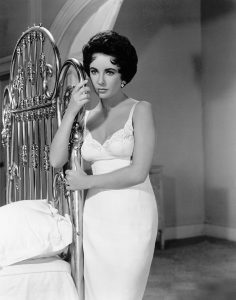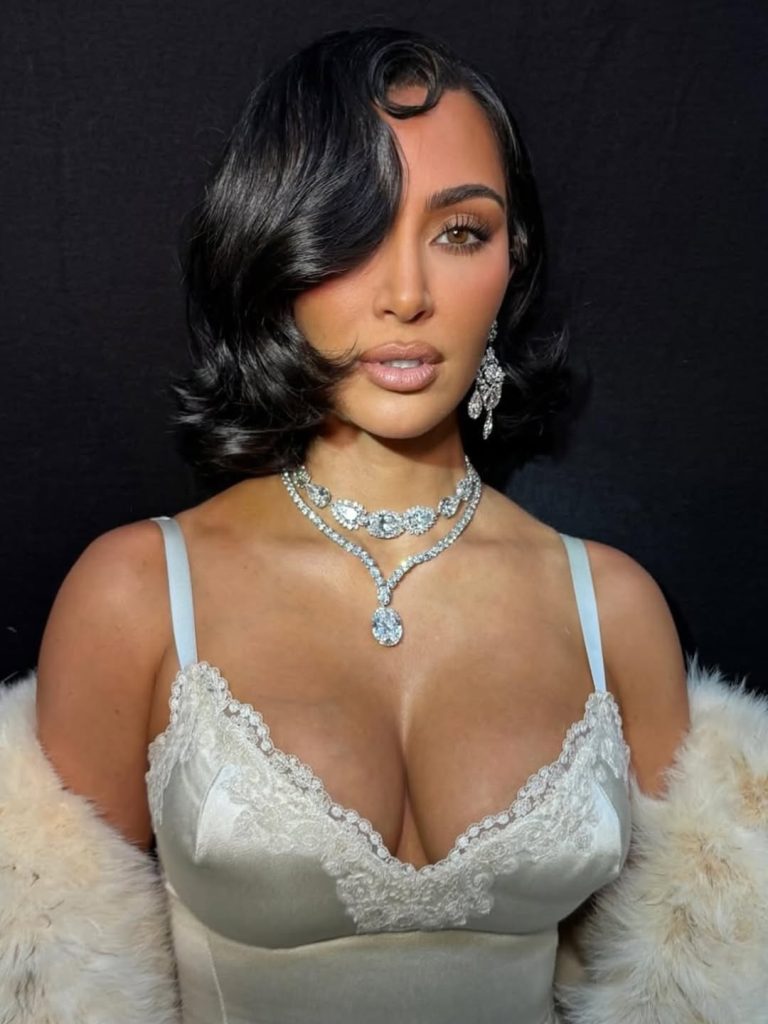
On a sultry Paris evening, as the city glimmered under a lavender dusk, the fashion world witnessed a moment destined to be etched into cultural memory. Kim Kardashian, reality TV star turned entrepreneur and global fashion muse, took to the Balenciaga runway — not merely as a celebrity guest or front-row fixture, but as a model embodying creative director Demna’s radical vision. Yet it wasn’t only her presence that captivated; it was the sparkling provenance she carried on her ears. Hanging delicately from her lobes were none other than Elizabeth Taylor’s famed diamond earrings, pieces once worn by the Hollywood legend herself.
It was an intersection of two icons: one born of Old Hollywood glamour and scandal, the other a modern-day symbol of social media-fueled celebrity and entrepreneurial savvy. Together, they created a narrative that went far beyond fashion — it became a commentary on fame, legacy, and the perpetual reinvention of image.
The diamond lineage: From Cleopatra to Calabasas
Elizabeth Taylor was no stranger to spectacular jewels. Her collection was the stuff of legend: from the Krupp diamond (later renamed the Elizabeth Taylor diamond) to the La Peregrina pearl, Taylor’s acquisitions were as dramatic as her on-screen performances and off-screen romances. Among her most beloved pieces were her diamond chandelier earrings, a gift from her third husband, producer Mike Todd. Taylor famously declared, “Big girls need big diamonds,” a mantra that echoed her fearless approach to life and love.
The earrings, intricate in their design and staggering in their brilliance, symbolized an era when Hollywood stars were otherworldly, shimmering like distant constellations rather than walking among us. When they appeared at auction following Taylor’s death in 2011, they fetched record sums, cementing their status not merely as accessories but as cultural relics.
Fast forward to 2025, and these same earrings found themselves in an entirely new context. Kim Kardashian, whose fame blossomed in the glare of reality TV cameras and Instagram filters rather than on the silver screen, wore them to close Balenciaga’s Fall/Winter 2025 haute couture show. The earrings, once symbols of a bygone Hollywood, now adorned a figure emblematic of modern celebrity — a perfect, if unexpected, reincarnation.
Kim Kardashian: A modern myth
To understand the resonance of this moment, one must first understand Kim Kardashian’s journey. From her early days as Paris Hilton’s stylist and friend to the launch of her global beauty, shapewear, and media empire, Kardashian has consistently defied the limitations of traditional celebrity. Her trajectory exemplifies the transformation of fame itself: from studio-controlled starlets to algorithm-driven influencers, from distant icons to hyper-accessible moguls.
Kardashian has long demonstrated a strategic approach to image-making, adeptly using every medium at her disposal. Her relationship with Balenciaga, cultivated through numerous public appearances and collaborations, particularly under Demna’s tenure, signifies a mutual fascination. For Balenciaga, Kardashian embodies the intersection of high fashion and popular culture; for Kardashian, the brand offers a canvas to project a more avant-garde, sculptural vision of her persona.
Demna’s Balenciaga: Radical reinvention
Demna’s work at Balenciaga has been defined by his fearless dismantling of fashion’s conventions. From dressing models in duct-tape ensembles to staging dystopian runway sets, his designs often read as social commentary as much as wearable art. In inviting Kardashian not only to wear his creations but to serve as a living canvas for a historical jewel, Demna once again challenged the boundaries between celebrity and muse, commodity and icon.
The choice of Elizabeth Taylor’s earrings was far from random. By pairing a symbol of Old Hollywood excess with Kardashian’s contemporary brand of fame, Demna orchestrated a collision of epochs. It was a bold statement on legacy and reinvention: How does a jewel’s meaning shift across generations? How does celebrity evolve from 20th-century cinema to 21st-century digital omnipresence?
The look: Monumental minimalism meets maximalist heritage
Kardashian’s runway look was, in typical Demna fashion, stark yet monumental. She emerged in a sculpted black satin column gown, its minimal silhouette emphasizing her statuesque figure. The gown’s precise architectural folds mirrored Cristóbal Balenciaga’s original mastery of shape, yet it was stripped of embellishment, forcing all eyes upward — to the earrings, shimmering like constellations against her sleek pulled-back hair.
The absence of other jewelry or accessories allowed the earrings to serve as a focal point, a talisman linking Kardashian’s present moment to Taylor’s enduring mystique. Makeup was kept luminous and minimal: sculpted cheekbones, a pale glossy lip, and the faintest hint of smokey shadow, an echo of classic Hollywood glamour without veering into pastiche.
On her feet, impossibly high black patent stilettos added a futuristic edge, nodding to Balenciaga’s ongoing exploration of cyber-goth and dystopian aesthetics. The overall effect was that of a living sculpture — a human monolith bridging eras, sensibilities, and cultural narratives.
Public reaction: A moment goes viral
Almost instantaneously, images and videos of Kardashian striding down the runway flooded social media. The Internet’s response was a tapestry of awe, critique, and fascination. Commentators marveled at the audacity of pairing such historically significant jewels with a reality TV star, while others lauded the move as a brilliant act of cultural recontextualization.
Fashion critics drew parallels to Andy Warhol’s obsession with celebrity as both product and subject. Meanwhile, cultural theorists dissected the interplay between authenticity and artificiality, noting how Kardashian’s brand thrives on the tension between raw vulnerability and meticulously curated imagery.
This moment also reignited discussions about the ownership of cultural heritage. Did Kardashian’s wearing of Taylor’s earrings democratize their allure, or did it risk reducing them to mere spectacle? Such questions are precisely what Demna’s Balenciaga seems to relish provoking, pushing the audience to confront their assumptions about value, fame, and authenticity.
The continuing legacy of Elizabeth Taylor
Elizabeth Taylor remains an enduring symbol of a more opulent, mythic form of celebrity. Her jewelry collection, amassed through decades of love affairs, studio contracts, and global adventures, is as much a part of her legend as her performances.
Her earrings, specifically, represent both personal and public facets of her life. They adorned her at major film premieres and intimate dinner parties, embodying the paradox of her persona: extravagantly public yet fiercely personal. By lending these earrings a new narrative on the Balenciaga runway, their meaning was both preserved and expanded.
Kardashian, knowingly or not, stepped into Taylor’s legacy not as an imitator but as a contemporary foil. Where Taylor’s jewels symbolized classic Hollywood’s unreachable glamour, Kardashian’s wearing of them suggested a new kind of accessibility — the idea that icons today are co-created in real time by audiences, hashtags, and viral memes.
The business of spectacle
Beyond the cultural analysis, this runway moment also underscores the modern business of fashion and celebrity. For Balenciaga, Kardashian’s appearance generated unparalleled publicity, instantly saturating global media channels and likely resulting in a surge of commercial interest.
For Kardashian, the appearance reinforced her evolving fashion credentials. It signaled her as more than a consumer of luxury — she is now an active participant and shaper of its contemporary narrative. In an age where every public move is meticulously strategized, wearing Taylor’s earrings wasn’t merely about aesthetic impact; it was a strategic alignment with history, luxury, and art.
The earrings themselves, already astronomically valued, have likely appreciated even further after this reintroduction to public consciousness. Auction houses and collectors understand that provenance is not static; it evolves as pieces accumulate new stories and cultural imprints.
A performance of power
Walking the runway in these earrings wasn’t just a fashion statement — it was a performance of power. Kardashian demonstrated her ability to access cultural artifacts once reserved for an elite circle of old-money collectors and Hollywood aristocrats. It underscored her position as a gatekeeper of contemporary luxury, a woman capable of rewriting what exclusivity means in the 21st century.
Elizabeth Taylor once said, “I’m a very committed wife. And I should be committed too — for being married so many times.” The humor and defiance in this line mirror the spirit of Kardashian’s runway appearance. It was an act of irreverence, reverence, and reinvention all at once.
The future of archival fashion
As archival fashion continues to captivate the industry, we’re seeing a renewed emphasis on pieces that carry stories — objects with soul, history, and a sense of continuity. In this context, Kardashian’s turn on the Balenciaga runway wasn’t just about aesthetic shock value. It was a statement on the enduring power of artifacts, the allure of historical provenance, and the modern appetite for hybrid narratives that merge past and present.
This is more than nostalgia. It is an active reimagining of fashion’s role as a living, evolving conversation. By placing a piece of Elizabeth Taylor’s personal history on a global stage, Balenciaga and Kardashian transformed a beautiful object into a cultural argument, one that challenges the ephemeral nature of trends and the cyclical patterns of fame.
When worlds collide
In the glittering collision of Kardashian and Taylor, orchestrated on the Balenciaga runway, we witnessed more than a fashion stunt. We saw the convergence of eras, values, and visions of womanhood. It was a testament to the power of fashion as a narrative device — capable of carrying forward legacy while simultaneously redefining it.
For Kim Kardashian, the moment cemented her position not just as a wearer of luxury but as an architect of contemporary cultural moments. For Balenciaga, it reinforced the brand’s commitment to pushing boundaries, questioning norms, and reimagining what high fashion can be in an age dominated by digital personas and viral spectacle.
Elizabeth Taylor’s diamonds will forever be entwined with the story of Hollywood’s golden age, yet thanks to this moment, they now possess a new chapter — one that reflects our current obsession with celebrity, reinvention, and the meaning of legacy.
As the lights dimmed on that Paris runway and Kardashian disappeared behind the black velvet curtains, the conversation had only just begun. Diamonds, after all, are forever — and so too are the stories we attach to them.
No comments yet.








